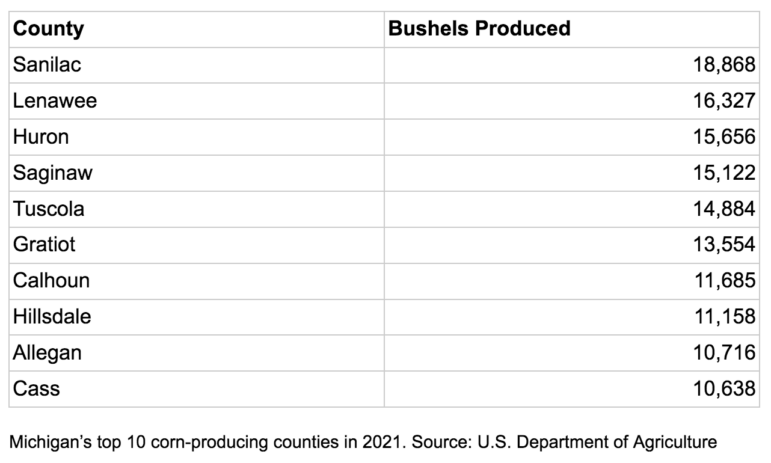
U.S. Department of Agriculture
The 10 largest corn-growing countiesBy ALEX WALTERS
Capital News Service
LANSING — Michigan’s corn farmers rejected a recent proposed assessment increase amid low prices, blocking additional funds for research and marketing.
The proposal would have raised the assessment from 1 cent per bushel to 2 cents.
The vote failed narrowly, with 48% of participating producers voting yes and 52% voting no, according to the Department of Agriculture and Rural Development. Such assessments fund commodity organizations that promote their crops.
It’s the third time corn growers have rejected a proposed increase in the last 10 years, said Jennifer Holton, a public information officer for the department.
Corn is the largest crop in Michigan with a commodity organization. Among the others are apple, asparagus, cherry, blueberry and soybean groups.
Carrot growers are next in line for an assessment increase vote. It runs until April 12.
The proposed increase for corn would have funded marketing efforts to support growers and research into corn-based aviation fuels, said Jim Zook, the executive director of the Corn Marketing Program of Michigan.
The commodity group will still attempt that work, but it will move much slower, Zook said.
“We still plan to do it, but we won’t be as effective,” he said. “Some of the work will have to be paused a little bit, and what we can do, it will take much longer to accomplish our end goals.”
That’s not good, Zook said, because “time is money for our producers.”
Many farmers would support the proposed work, but “bad timing” deterred them from voting for it, said Jed Welder of Trinity Farms in Greenville. He represents central Michigan on the Corn Marketing Program’s board.
Corn prices have dropped dramatically in the last year, according to U.S. Department of Agriculture data.
If a vote occurred when prices were higher, it could pass, Welder said.
Zook, however, said it’s not that simple because holding a vote is a months-long process. Prices could change during that window, affecting farmers’ decisions.
“If someone could look into a crystal ball for us and tell us what it’s going to be, this would be a lot easier,” he said.
The larger problem is that it can take nearly a decade for farmers to see the results of research and advocacy work, Zook said, and it is hard to have that kind of patience.
“Producers are used to planting a crop in the spring and seeing the results of their labor a few months later,” he said. “What we do takes much more time. I think the challenge for many producers is just seeing that.”
Farmers can get caught up in thinking about only their farm and profits, hurting the industry overall, Welder said.
“A lot of the time, farmers get a real narrow focus on ‘my fields, my labor, my equipment,’” Welder said “It’s hard for us to come off our acres and look at the broader perspective.”
Some corn growers say they’re unconcerned about the assessment process altogether.
Eric Bronson, of Bronson Farms in Sherwood, said he didn’t know an assessment vote was held at all.
He doesn’t always open envelopes from the Department of Agriculture and Rural Development because the assessment “gets deducted either way.”
“It all seems like something people would think a lot more about when corn’s $6 as opposed to $4” a bushel, Bronson said.